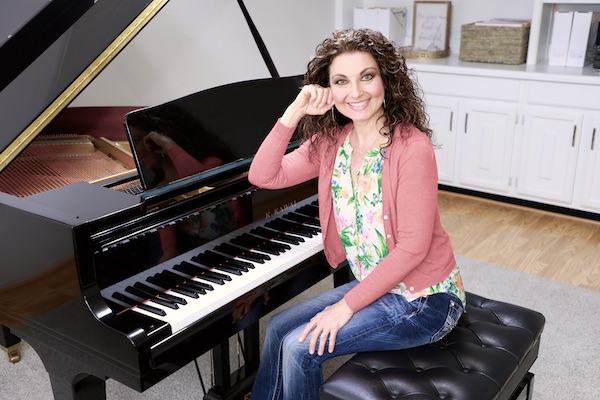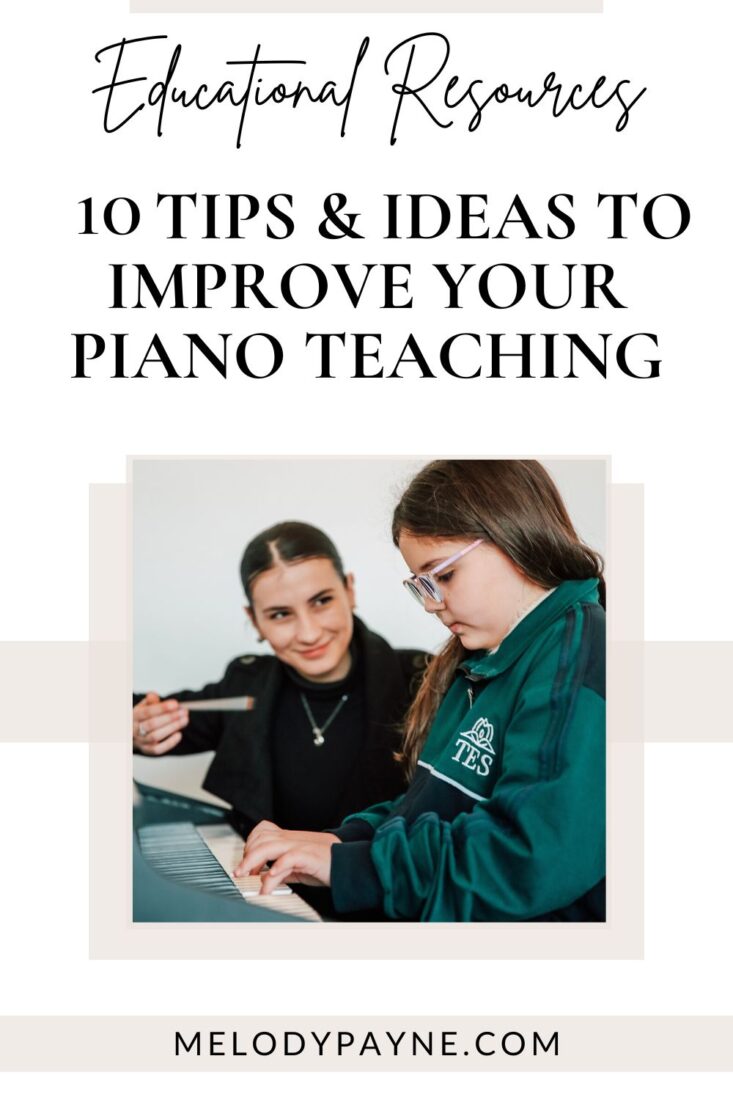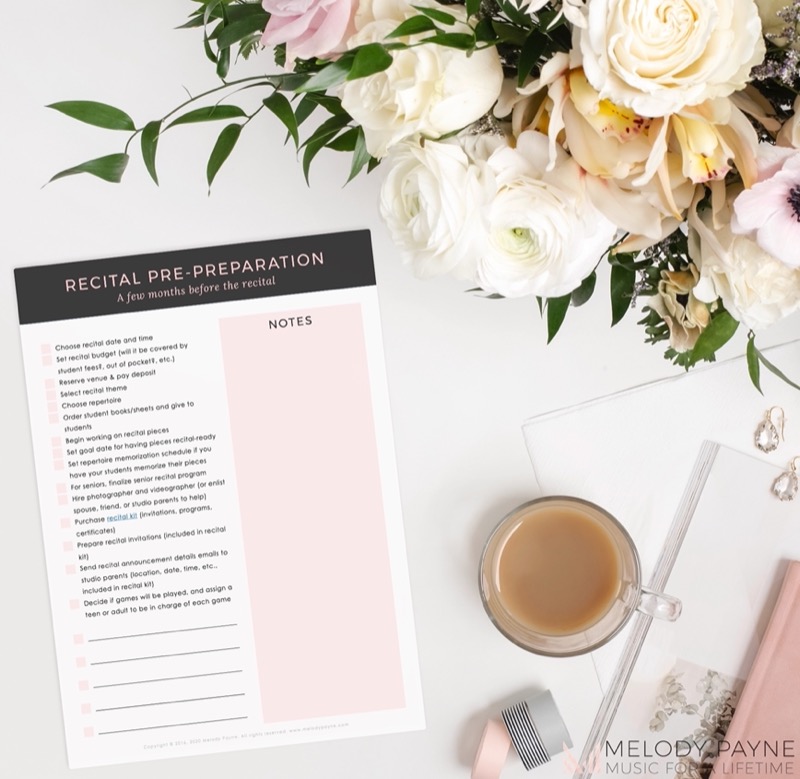Chest Stretches to Improve Piano Posture
This post may contain affiliate links. If you purchase something through an affiliate link, I will receive a small commission at no cost to you. For more information, read the disclosure statement here.
Today we’re talking about how to improve piano posture with chest stretches.
This is Part 3 of our Piano Teacher Wellness series, in which we’re addressing the issues that cause neck and back pain from spending hours each day teaching piano lessons in person and online.
I interviewed my physical therapist, Stephanie Elkins, DPT, to see how we can prevent these pain and improve piano posture issues.
In this series, Stephanie is answering my questions about the causes of “Tech Neck” (the rounded shoulders and hunched back we’re all so familiar with).
She’s also teaching us how to strengthen the weak muscles that contribute to back and neck problems.
She even provides tips for how to reverse the painful issues that stem from spending so much time sitting in front of our devices with less than ideal posture!
If you’ve missed the other parts in this series, catch up here:
The rest of this article is in interview format. Please enjoy this informative and enlightening question and answer session between my sister Stephanie and I and learn an easy way to improve piano posture.
Legal Disclaimer: This article is not intended to be medical advice.
It is intended for demonstration purposes only and should not be used to self-diagnose or self-treat any condition.
Consult with your own medical professional before starting any new exercise program.
You agree to hold harmless this site and all individuals involved in the publication of this article for any damages resulting from the use or misuse of this article’s content.
Use of any content in this article is at your sole risk.
Piano Posture Series Recap
Melody: In our previous two articles, we discussed some common pain issues piano teachers experience, specifically, thoracic kyphosis with forward head posture, casually known as “tech neck”.
We learned how chin tucks, scapular retractions, and high and low rows can strengthen the neck and upper back to improve piano posture.
That strength can reverse and even eliminate the pain that comes from the slouchy back posture we often use when we’re sitting in front of our devices.
I’ve been working hard on my scapular retractions and chin tucks (my upper back was sore the first few days!), and I’m looking forward to learning some new exercises this week to strengthen my piano posture even more!
What tips do you have for us this week to improve piano posture, Stephanie?
Stephanie: In Part 2 of this piano posture series, we talked about slouching issues, or tech neck, as it pertains to the upper back.
This week, we’ll be addressing the anterior muscles.
Anterior Muscles
Melody: What are the anterior muscles, and what can we do to help them and improve piano posture?
Stephanie: The anterior muscles are the muscles on the front of the body, the chest and abdominal muscles.
In a nutshell, we have to stretch the anterior muscles (front) so we can strengthen the posterior muscles (back).
Melody: What role do the anterior muscles play to improve piano posture?
Stephanie: When we’re in the forward rounded position I mentioned in the previous articles, the pecs and the abdominals are compressed.
This means all of those muscles on the front of the body are in their shortest position possible since we are in a slouched position.
We need to stretch the chest, front of the shoulders, and pec muscles to open the chest and lengthen the anterior muscles.
We’ll address the abs more in Part 4 of our series, but today’s exercise can also stretch the abs and get them out of the compressed position.
Melody: Sounds great! How do we stretch those anterior muscles and open the chest so we can reduce pain and improve piano posture?
Stephanie: Doorway stretches are a wonderful way to stretch the anterior muscles and open the chest.
How to Perform Doorway Stretches
Stephanie: To perform doorway stretches correctly, bring your elbows out 90 degrees from your body, and bend your elbows roughly 90 degrees. Stand in the middle of the doorway.
Put a forearm on each door frame and step forward with either foot, through the door, with your forearms and hands on the doorframe, until you feel a stretch.
Hold for 15 to 30 seconds, depending on your comfort level. Listen to your body. You want to feel a stretch, not pain.
Melody: Doorway stretches are my favorite! I can literally feel the tight muscles stretching and opening up. This is my go-to way to improve piano posture, as well as computer posture!
Repetitions
Do at least 1 set of 3 repetitions. Repeat 2-3 times a day. After a day or two, your muscles may feel a little sore, but that is normal and expected.
A special thank you to Kacee Rose, LPTA, for demonstrating the correct performance of this exercise in the following video.
Recommended Tools:
If you’re looking for more ways to improve piano posture, reduce pain, and help you feel better while teaching piano lessons, here are some of our favorites.
- Stephanie’s favorite ice pack for sore muscles
- Stephanie’s favorite Therabands for high and low rows
- Stephanie’s favorite yoga mat for chin tucks
- Melody’s favorite equipment for online piano lessons
Other resources for piano teachers
Don't miss out!
Follow us on Facebook and Instagram, join our Facebook group for piano teachers, and subscribe to the newsletter to get helpful teaching tips, resources, and tutorials delivered straight to your inbox every week.
Stephanie Elkins
Stephanie Elkins
Welcome!

Hi! I’m Melody Payne, a pianist and piano teacher, educational resource author, a fun-loving wife to the most wonderful and talented hubby I could ask for, and a lifelong learner who loves to share. I want to make your life as a music teacher easier by writing and sharing helpful and relevant music teaching articles, and by creating educational resources with your very own students in mind. If you are a parent who wants to enroll your child in piano lessons, I’d love for us to get started building those skills that can give your child a lifetime of musical enjoyment!








